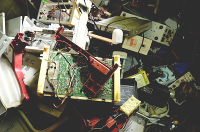 Add My Company
Add My Company
Sign In
Why E-Waste Recycling Is Important
05-07-2016

E-waste is an ever expanding blight on the planet. The amazing array of innovative technologies we depend on for our day-to-day are taking a serious toll on the environment, through the extraction of rare metals and other resources, compounded by the excessive dumping of anything deemed broken or obsolete. The dumps are usually vast, toxic wastelands, with more e-waste arriving each and every day.
E-waste generation is expected to reach some 93.5 million tons by the end of 2016, up from around 41.5 million tons in 2011. That is a compound annual growth of 17.6% - and is only set to rise.
We know it is bad. We do. But why should more be done to extract the already expended resources present in so many e-waste dumps?
Precious Metals Abound
Precious metals are, well, precious. Amongst their ranks are some of the rarest metals to be found around the world, and as long as humans have been digging shiny things out of the ground, they have been coveted. Now, they’re worth so much more as integral components of the many devices we covet.
Metals such as platinum, palladium, rhodium, ruthenium, iridium and osmium have high melting points, high corrosion resistance and excellent catalytic properties, making them extremely desirable in many industrial and commercial devices. Consider an iPhone 5, the previous generation of Apple’s flagship smartphone. It contains “$1.58 of gold, $.36 of silver, $.05 of platinum, and $.12 of copper,” as well as trace amounts of “rare earths” Yttrium, Lanthanum, Neodymium, Gadolinium, and Europium, among others.
You may have never heard of some of these, and understandably so. However, that doesn’t solve the burning issue: recycling and reusing these rare metals and rare earths is difficult, and is certainly not environmentally friendly. Extracting any meaningful amount of these materials usually involves seriously toxic heavy metals, further poisoning the environment, as well as those unlucky individuals dependent on their extraction for a living.
Urban Mining
As it stands, the concentration of these precious and rare materials is vastly higher in e-waste dumps than as ore in the ground. It should also be noted that a vast majority of the initial leg-work has been done, as the ore has already been extracted, refined, and constructed. However, even with concentrated sources covering the globe, there are several conditions that must be in place for e-recyclers to consider extraction.
Value. Seemingly obvious, but there must sufficient value in the specific metals for a recycling project to be deemed viable.
Volume. Accompanying value, there must be sufficient volume of the precious and rare metals to ensure a profitable extraction process.
Efficiency. Can the metals be extracted with sufficient efficiency, using capable technology?
The first two are easily met in most e-waste dumps, but the third is certainly more challenging and without significant investment in machinery, usually takes place by hand. Not only is this extremely hazardous, but also returns very little of the already minute traces of precious metals and earths.
Will It Change?
In the near future? No. Not without serious investment in the countries dotted around the globe willingly (and sometimes unwillingly) accepting the vast volume of e-waste. But until attitudes in innovative technologies, commercial and industrial organisations, and indeed, the general public change, the problem will continue to grow.
For more information on Why E-Waste Recycling Is Important talk to Hawkshead Designs Ltd
Enquire Now
List your company on FindTheNeedle.

